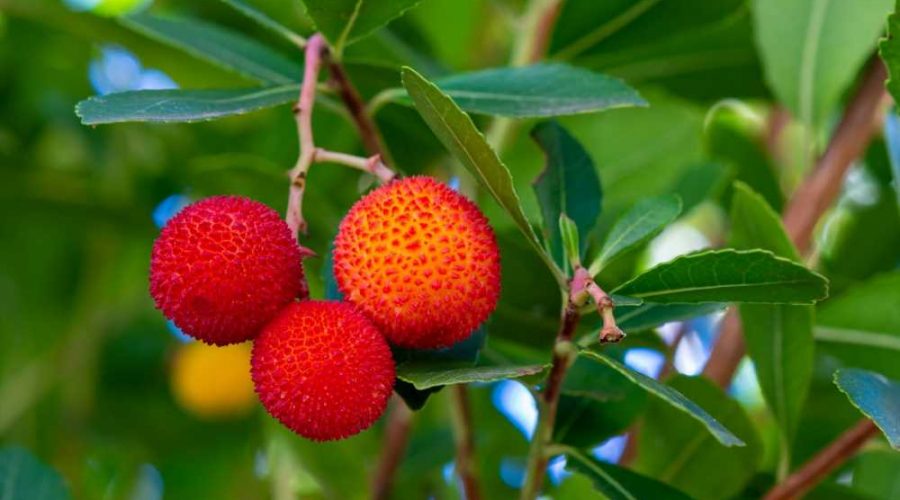New Mediterranean plant-based smoothies show promising health benefits, study finds
A recent study published in the Antioxidants journal analyzed the potential health-promoting activities of innovative smoothies made from some typical Mediterranean plant products, such as apple (Malus domestica (Md) juice, strawberry tree (Arbutus unedo (Au) fruit puree and enriched with Myrtus communis (Mc) purple berry extract, Crocus sativus (Cs) petal juice, Acca sellowiana (As), and Diospyros kaki (Dk) fruits.
 Study: Antioxidant Activity and Inhibition of Digestive Enzymes of New Strawberry Tree Fruit/Apple Smoothies. Image Credit: HJBC / Shutterstock
Study: Antioxidant Activity and Inhibition of Digestive Enzymes of New Strawberry Tree Fruit/Apple Smoothies. Image Credit: HJBC / Shutterstock
Introduction and Background
Significant changes have occurred in the food industry over the past few years due to the relationship between human health and nutritional food components, resulting in a trend of healthy eating. In addition, consumer trends have moved towards choosing products based on sensory properties and their nutritional and health properties.
This has led the food industry to develop safe, healthy, and attractive products to meet customer demands. Among ready-to-drink beverages, smoothies are of increasing interest. They are smooth-consistency, semi-liquid beverages prepared by mixing vegetables, fruits, and other components. They are termed superfoods due to their beneficial and health-protecting qualities.
Antibodies eBook

Products with antidiabetic or antioxidant properties that can be taken daily by healthy individuals and those suffering from chronic diseases are important. Treatment and prevention of these diseases involve consuming foods rich in antioxidants such as polyphenols and reducing vitamins.
However, these compounds are lost in ready-to-eat foodstuffs or highly processed products available at food stores. Therefore, food production technology needs to ensure the presence of human health-promoting compounds in final food products.
Phenolic compounds, such as flavonols, anthocyanins, phenolic acids, or flavan-3-ols, a subgroup of flavonoids, are important natural oxidants in many fruits or vegetables. Polyphenols help to reduce the progression of cardiovascular diseases, diabetes, cancer, and neurodegenerative disorders, as well as act as prebiotics.
Anthocyanin is an important phenolic compound responsible for plants' red-purple color. These compounds are useful in treating diseases related to oxidative stress, including cancer, diabetes, and Alzheimer's disease, as well as inflammation and cancer. Moreover, bioactive compounds from fruits can help stimulate insulin secretion and reduce blood pressure, serum cholesterol, and triglycerides.
About the study
The study involved the production of strawberry tree fruit/apple smoothie by mixing strawberry tree fruit mousse with apple juice in a ratio of 25:75. Assays were performed to determine the total reducing power, total phenolic content, and free radical scavenging activity.
Intestinal Caco-2 cells were used to carry out an MTT assay that analyzes the toxic activity of the tested extracts and intracellular ROS production. Digestive enzyme inhibition assays and identification and quantification of the extracted polyphenolic compounds followed this. The phloroglucinol method was used to analyze the polymeric procyanidins. Finally, the sugar and organic acid content of the extract was determined.
Study findings
The results indicated that the highest antioxidant activity ranged from 6.98 mmol Fe2+/100 g fresh weight (fw) (Au/Md) to 8.75 mmol Fe2+/100 g fw (Au/Md + Mc). The most significant antioxidant activity was observed in Au/Md + As and Au/Md + Dk and was positively associated with increased total phenolic content.
None of the final product extracts were reported to decrease cell viability. Moreover, pre-treatment with all phenolic extracts was observed to be associated with the inhibition of ROS formation.
Au/Md + Dk, Au/Md + As, and Au/Md + Mc were reported to lead to slightly lower ROS levels than the other two. Additionally, the percentage of ROS production in extracts with concentrations of 10 and 20 µg/mL was observed to be equal to the untreated cells.
The inhibitory activity against α-amylase was reported to range from 64.70 (Au/Md + Mc) to 94.90 (Au/Md) mg fw/mL, with persimmon (Dk) puree and feijoa (As) flowers being the most potent inhibitors.
The inhibitory activity against α-glucosidase ranged from 15.84 (Au/Md + Mc) to 27.12 (Au/Md + Cs) mg fw/mL, and the same α-amylase inhibition group showed the strongest inhibition. The inhibitory activity against pancreatic lipase ranged from 3.01 (Au/Md) to 3.14 (Au/Md + Mc) mg fw/mL, with Au/Md being the most potent inhibitor.
75 different polyphenols were observed in the five smoothies that belonged to six subclasses, hydroxybenzoic and hydroxycinnamic acids, anthocyanins, flavan-3-ols, dihydrochalcones, flavonols, and anthocyanins.
The total amount of polyphenols was reported to be different in all the smoothies; however, supplementation with feijoa flowers or 5% purple myrtle berry extract was observed to further enrich the natural antioxidants in the final product. Nine anthocyanins were observed, whose amounts ranged between 530.72 and 635.96 mg/100 g.
The pure Au/Md smoothie was rich in such molecules, mostly cyanidin-3-O-arabinoside and cyanidin-3-O-galactoside. Adding 5% purple myrtle (Mc) berry extract to the smoothie was observed to enrich it in delphinidin-3-O-galactoside and -3-O-glucoside, malvidin3-O-glucoside, and -3-O-glucoside, peonidin-3-O-glucoside. Additionally, delphinidin-3,5-Odiglucoside was observed in smoothies enriched with saffron petal juice.
Furthermore, 24 hydroxybenzoic acids and their derivatives were observed in all the smoothies. However, their composition was different in different products: gallic acid glucoside I and II, digalloyl shikimic acid I, digalloylquinic acid I, and galloyl shikimic acid, theogallin, and galloyl glucoside I were contained in all smoothies.
The detected hydroxycinnamic acids involved p-coumaric acid, caffeic acid, p-coumaroyloquinic acid, as well as neo-chlorogenic and chlorogenic acid. Two dihydrochalcones were reported in all smoothies, whose amount was increased by adding saffron (Cs) petal juice and myrtle (Mc) berry extract, while it decreased with the addition of feijoa flowers and persimmon puree. Moreover, several flavonols and flavan-3-ols were reported whose composition differed based on the final product.
Additionally, sorbitol, sucrose, glucose, and fructose were reported in all final products, and the total sugar content ranged from 13.27 to 16.50 g/100 g. The highest sugar content was observed in the smoothie enriched with myrtle purple berry extract, while the lowest was in the pure base.
The most abundant sugars were reported to be glucose and fructose. The addition of semi-products to the pure base was observed to increase the fructose content, but the opposite was true for glucose. Eight organic acids were reported in the final products, including citric, oxalic, ascorbic, quinic, malic, shikimic, isocitric, and fumaric acid.
Among them, quinic and malic acid was the most abundant. Additionally, the general sugar: organic acid ratio increased due to each additional component compared to the pure base.
Conclusion
Therefore, the current study indicated that a strawberry tree/apple fruit smoothie could be an important source of bioactive compounds inhibiting some digestive enzymes and antioxidant activity.
Enrichment of the smoothie with different plant materials can further improve its nutraceutical potential. The development of more such smoothies can help to support the local food production chain as well as promote healthy lifestyles.
Limitations
One major limitation of the study is that it uses in vitro models, and the results cannot be translated in vivo.
- Gil, K. et al. (2023) "Antioxidant Activity and Inhibition of Digestive Enzymes of New Strawberry Tree Fruit/Apple Smoothies," Antioxidants, 12(4), p. 805. doi: 10.3390/antiox12040805. https://www.mdpi.com/2076-3921/12/4/805
Posted in: Medical Science News | Medical Research News | Medical Condition News
Tags: Alzheimer's Disease, Anthocyanin, Antioxidant, Assay, Blood, Blood Pressure, Cancer, Cell, Cholesterol, Chronic, Compound, Diabetes, Enzyme, Food, Food Production, Fructose, Fruit, Glucose, in vitro, in vivo, Inflammation, Insulin, Intracellular, Lipase, Nutraceutical, Oxidative Stress, Persimmon, Prebiotics, Saffron, Stress, Technology, Vegetables, Vitamins

Written by
Suchandrima Bhowmik
Suchandrima has a Bachelor of Science (B.Sc.) degree in Microbiology and a Master of Science (M.Sc.) degree in Microbiology from the University of Calcutta, India. The study of health and diseases was always very important to her. In addition to Microbiology, she also gained extensive knowledge in Biochemistry, Immunology, Medical Microbiology, Metabolism, and Biotechnology as part of her master's degree.
Source: Read Full Article
